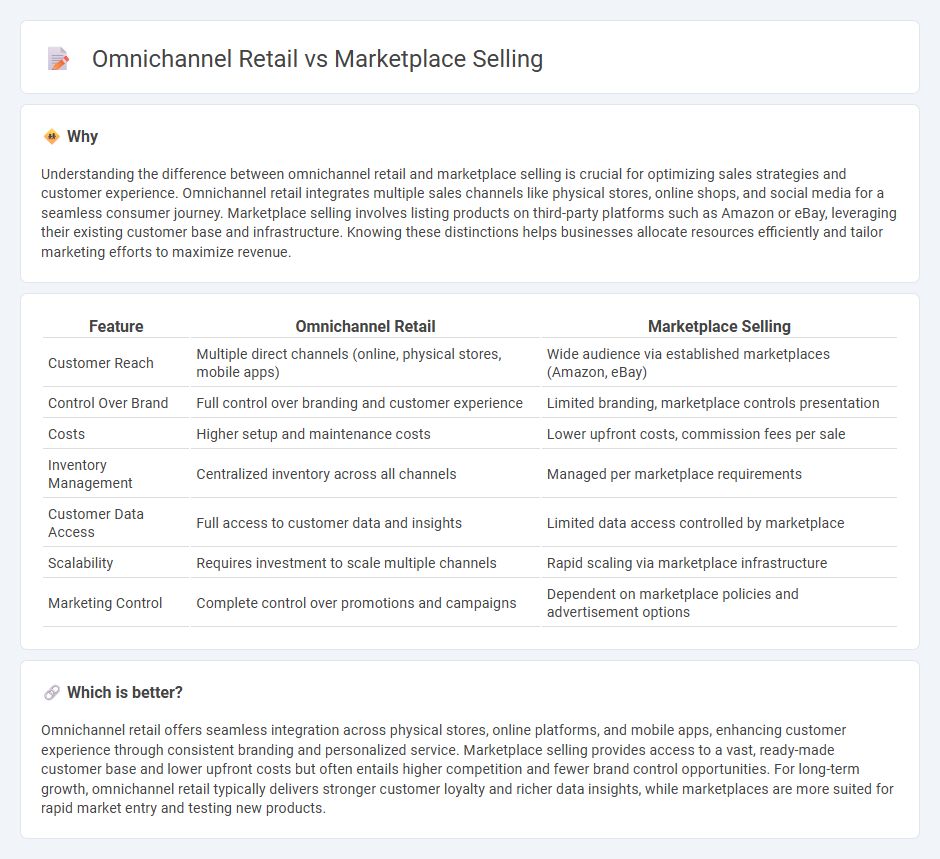
Omnichannel retail integrates multiple sales channels, including physical stores, online platforms, and mobile apps, to provide a seamless customer experience. Marketplace selling leverages third-party platforms like Amazon or eBay, allowing businesses to reach wider audiences without managing individual storefronts. Explore how these strategies impact sales growth and customer engagement in modern commerce.
Why it is important
Understanding the difference between omnichannel retail and marketplace selling is crucial for optimizing sales strategies and customer experience. Omnichannel retail integrates multiple sales channels like physical stores, online shops, and social media for a seamless consumer journey. Marketplace selling involves listing products on third-party platforms such as Amazon or eBay, leveraging their existing customer base and infrastructure. Knowing these distinctions helps businesses allocate resources efficiently and tailor marketing efforts to maximize revenue.
Comparison Table
| Feature | Omnichannel Retail | Marketplace Selling |
|---|---|---|
| Customer Reach | Multiple direct channels (online, physical stores, mobile apps) | Wide audience via established marketplaces (Amazon, eBay) |
| Control Over Brand | Full control over branding and customer experience | Limited branding, marketplace controls presentation |
| Costs | Higher setup and maintenance costs | Lower upfront costs, commission fees per sale |
| Inventory Management | Centralized inventory across all channels | Managed per marketplace requirements |
| Customer Data Access | Full access to customer data and insights | Limited data access controlled by marketplace |
| Scalability | Requires investment to scale multiple channels | Rapid scaling via marketplace infrastructure |
| Marketing Control | Complete control over promotions and campaigns | Dependent on marketplace policies and advertisement options |
Which is better?
Omnichannel retail offers seamless integration across physical stores, online platforms, and mobile apps, enhancing customer experience through consistent branding and personalized service. Marketplace selling provides access to a vast, ready-made customer base and lower upfront costs but often entails higher competition and fewer brand control opportunities. For long-term growth, omnichannel retail typically delivers stronger customer loyalty and richer data insights, while marketplaces are more suited for rapid market entry and testing new products.
Connection
Omnichannel retail integrates multiple sales channels, including physical stores, online platforms, and mobile apps, to provide a seamless customer experience. Marketplace selling acts as a critical component in this ecosystem by expanding product reach and increasing visibility through third-party platforms like Amazon, eBay, and Alibaba. Both strategies leverage data analytics and inventory synchronization to optimize sales performance and enhance customer satisfaction across diverse touchpoints.
Key Terms
Channel Integration
Marketplace selling leverages third-party platforms like Amazon and eBay to reach broad audiences, streamlining product visibility without managing individual sales channels. Omnichannel retail integrates multiple sales avenues--including online stores, physical outlets, and social media--providing a seamless customer experience through unified inventory and personalized interactions. Explore deeper strategies and benefits to master channel integration effectively.
Customer Touchpoints
Marketplace selling centralizes customer touchpoints within a single digital platform, streamlining interactions through curated product listings, reviews, and seller communication channels. Omnichannel retail integrates multiple touchpoints across physical stores, websites, mobile apps, and social media, ensuring a seamless and consistent customer experience. Explore how optimizing these touchpoints enhances customer engagement and drives sales.
Inventory Synchronization
Inventory synchronization in marketplace selling relies on external platforms where inventory updates must be frequently pushed to prevent overselling, leading to delays and stock discrepancies. Omnichannel retail integrates inventory management across multiple channels, offering real-time, centralized stock visibility that enhances order accuracy and customer satisfaction. Explore the benefits of seamless inventory synchronization in transforming retail operations and boosting sales efficiency.
Source and External Links
How to sell on Facebook Marketplace for beginners - Facebook Marketplace allows sellers to reach a vast local audience with free listings, direct communication via Messenger, and flexible payment options including in-person and online checkout, making it a popular platform for diverse product sales and community engagement.
How to sell on Facebook Marketplace for beginners - To sell on Facebook Marketplace, you need an active profile, prepare compelling listings with quality photos and detailed descriptions, price competitively, and communicate clearly with buyers; for businesses, integrating eCommerce platforms can help scale sales.
22 Selling Websites and Marketplaces for Selling Things Online - Beyond Facebook Marketplace, numerous online marketplaces exist for selling items, with some specialized by niche and others general; running your own online store offers benefits like keeping full profits and building a brand with platforms such as Shopify.
 dowidth.com
dowidth.com